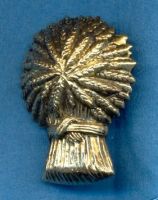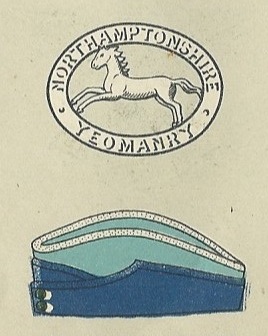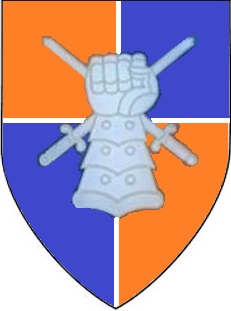
The Royal Armoured Corps is the component of the British Army, that together with the Household Cavalry provides its armour capability, with vehicles such as the Challenger 2 Tank and the Warrior tracked armoured vehicle. It includes most of the Army's armoured regiments, both the Royal Tank Regiment and those converted from old horse cavalry regiments. Today it comprises twelve regiments, eight regular and four reserve. Although the Household Cavalry Regiment provide an armoured regiment, they are not part of the RAC.

The South African Army is the principal land warfare force of South Africa, a part of the South African National Defence Force (SANDF), along with the South African Air Force, South African Navy and South African Military Health Service. The Army is commanded by the Chief of the Army, who is subordinate to the Chief of the SANDF.

The Rooikat is a South African armoured reconnaissance vehicle equipped with a stabilised 76 mm high velocity gun for organic anti-tank and fire support purposes. The Rooikat's main armament was built with the Oto Melara 76 naval gun as its basis, to which it is nearly identical in terms of technical performance and statistics. The Rooikat can also fire the same ammunition as the naval gun, albeit modified with new percussion primers in the shells.

The Pretoria Armour Regiment is a reserve armoured regiment of the South African Army.

The General Jan Smuts Regiment is a reserve mechanised infantry regiment of the South African Army.

The Molapo Armoured Regiment is a reserve armoured regiment of the South African Army.

The Blaauwberg Armoured Regiment is a reserve armoured regiment of the South African Army.

1 South African Tank Regiment is an armoured regiment of the South African Army, based at the Tempe military base in Bloemfontein as part of the South African Army Armour Formation.

The 23rd Armoured Brigade, originally formed as the 23rd Army Tank Brigade, was an armoured brigade of the British Army that saw service during the Second World War. The brigade was a 2nd Line Territorial Army (TA) formation. It was reorganised and renamed the 23rd Armoured Brigade, when it was assigned to the 8th Armoured Division, although it never operated under command of the division.

The Derbyshire Yeomanry was a yeomanry regiment of the British Army, first raised in 1794, which served as a cavalry regiment and dismounted infantry regiment in the First World War and provided two reconnaissance regiments in the Second World War, before being amalgamated with the Leicestershire Yeomanry to form the Leicestershire and Derbyshire Yeomanry in 1957.

The Rhodesian Armoured Corps, nicknamed the "Black Devils" — was the only standing armoured battalion of the Rhodesian Security Forces. During World War II, it took part in the Allied Spring 1945 offensive and the Battle of Monte Cassino as part of South Africa's 6th Armoured Division. The unit was among the first to enter a liberated Florence in July 1944. Prior to 1963, its crews were trained in the United Kingdom or Aden Colony and were known as the "Selous Scouts" under the Federation of Rhodesia and Nyasaland. After Rhodesia's Unilateral Declaration of Independence, maintaining the armoured vehicle fleet became a responsibility of the Rhodesian Light Infantry until Major Bruce Rooken-Smith reactivated the former Rhodesian Armoured Car Regiment in 1972. During the Rhodesian Bush War, the regiment fought in several major campaigns and battles, particularly Operation Miracle in September 1979. It was superseded by the new Zimbabwe Armoured Corps between 1980 and 1981.

The Second Battle of El Alamein was a battle of the Second World War that took place near the Egyptian railway halt of El Alamein. The First Battle of El Alamein and the Battle of Alam el Halfa had prevented the Axis from advancing further into Egypt.

The Fife and Forfar Yeomanry (FFY) was an Armoured Yeomanry Regiment of the British Army formed in 1793. It saw action in the Second Boer War, the First World War and the Second World War. It amalgamated with the Scottish Horse to form the Fife and Forfar Yeomanry/Scottish Horse in 1956. The lineage is maintained by "C" Fife and Forfar Yeomanry/Scottish Horse Squadron of The Scottish and North Irish Yeomanry based in Cupar in Fife.

The Lothians and Border Horse was a Yeomanry regiment, part of the British Territorial Army. It was ranked 36th in the Yeomanry order of precedence and was based in the Scottish Lowland area, recruiting in the Lothians – East Lothian (Haddingtonshire), Midlothian (Edinburghshire), and West Lothian (Linlithgowshire) – and along the border with England, particularly Berwickshire. It amalgamated with the Lanarkshire Yeomanry and the Queen's Own Royal Glasgow Yeomanry to form the Queen's Own Lowland Yeomanry in 1956.

The Northamptonshire Yeomanry was a Yeomanry regiment of the British Army, formed in 1794 as volunteer cavalry. It served in the Second Boer War, the First World War and the Second World War before being reduced to squadron level in 1956. It ceased to have a separate existence in 1971.

Armoured reconnaissance is the combination of terrestrial reconnaissance with armoured warfare by soldiers using tanks and wheeled or tracked armoured reconnaissance vehicles. While the mission of reconnaissance is to gather intelligence about the enemy with the use of reconnaissance vehicles, armoured reconnaissance adds the ability to fight for information, and to have an effect on and to shape the enemy through the performance of traditional armoured tasks.

The South African Army Armour Formation provides an Armour capability to the South African Army. The Formation came into being as part of a restructure. South African Armour Corps units previously under the command of various different brigades and other formations were all grouped under one formation. All armour is assigned to the SA Army Armour Formation under the charge of a General Officer Commanding.

The South African School of Armour is the training institute of the South African Armoured Corps located at Tempe, Bloemfontein.

Regiment Vrystaat was an armoured regiment of the South African Army. As a reserve unit, it had a status roughly equivalent to that of a British Army Reserve or United States Army National Guard unit. Formed from 2 Regiment President Steyn which had been formed in 1975, when 1 Regiment President Steyn was converted to tanks and 2 Regiment President Steyn formed with armored cars. It was part of the South African Army Armour Formation.

81 Armoured Brigade was a Formation of 8th Armoured Division, a combined arms force consisting of armour, mechanised infantry, and mechanised artillery.
























